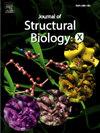Crystal structure reveals the hydrophilic R1 group impairs NDM-1–ligand binding via water penetration at L3
IF 5.1
Q2 BIOCHEMISTRY & MOLECULAR BIOLOGY
引用次数: 0
Abstract
The global spread of New Delhi metallo-β-lactamases (NDMs) has exacerbated the antimicrobial resistance crisis. This study resolved the crystal structure of NDM-1 hydrolyzing amoxicillin for the first time, revealed that the hydroxyl group in the R1 moiety of amoxicillin anchors a key water molecule (Wat1) via hydrogen bond, inducing a conformational shift in Met67 (average displacement of 3.8 Å compared to its position in complexes with ampicillin, penicillin G, and penicillin V) and impairing the hydrophobic interaction between the loop 3 and the substrate. Molecular dynamics simulations confirmed that the π-π stacking contact time between amoxicillin and the L3 critical residue Phe70 decreased to 4.3 % (ampicillin: 12.3 %), with a binding energy reduction of 10.5 kcal/mol. Steady-state kinetics showed that amoxicillin exhibited a 2.2-fold higher Km and a 5.2-fold higher kcat compared to ampicillin, demonstrating that hydrophilic R1 groups impair enzyme-substrate binding. This work demonstrates the essential role of hydrophobic interactions in L3-mediated substrate binding and provides a novel strategy for designing L3-targeted NDM-1 inhibitors: maximize hydrophobicity and minimize polar surface area in the L3 contact region to block water penetration, thereby stabilizing the inhibitor-L3 interaction.

晶体结构显示亲水性R1基团通过水渗透在L3破坏ndm -1配体的结合
新德里金属β-内酰胺酶(ndm)的全球传播加剧了抗菌素耐药性危机。本研究首次解决了NDM-1水解阿莫西林的晶体结构,揭示了阿莫西林R1部分的羟基通过氢键锚定一个关键水分子(Wat1),引起Met67的构象移位(与氨苄西林、青霉素G和青霉素V配合物的位置相比,其平均位移为3.8 Å),并损害了环3与底物之间的疏水相互作用。分子动力学模拟证实,阿莫西林与L3临界残基Phe70之间的π-π堆积接触时间降低至4.3%(氨苄西林:12.3%),结合能降低10.5 kcal/mol。稳态动力学表明,与氨苄西林相比,阿莫西林的Km和kcat分别高出2.2倍和5.2倍,这表明亲水性R1基团损害了酶与底物的结合。这项工作证明了疏水相互作用在L3介导的底物结合中的重要作用,并为设计L3靶向NDM-1抑制剂提供了一种新的策略:最大化疏水性并最小化L3接触区域的极性表面积以阻止水渗透,从而稳定抑制剂-L3相互作用。
本文章由计算机程序翻译,如有差异,请以英文原文为准。
求助全文
约1分钟内获得全文
求助全文
来源期刊

Journal of Structural Biology: X
Biochemistry, Genetics and Molecular Biology-Structural Biology
CiteScore
6.50
自引率
0.00%
发文量
20
审稿时长
62 days
 求助内容:
求助内容: 应助结果提醒方式:
应助结果提醒方式:


